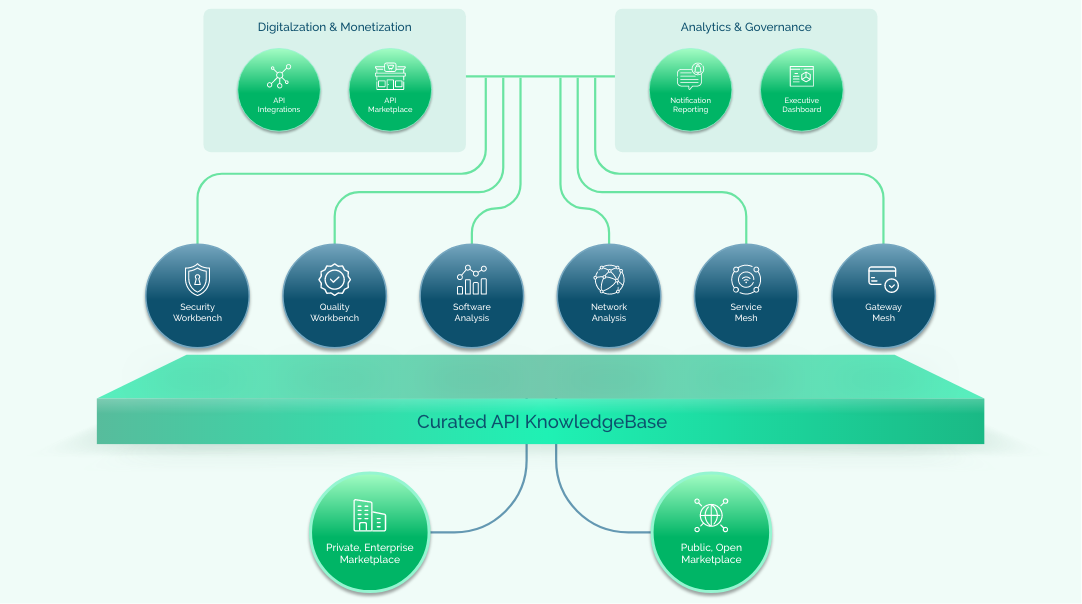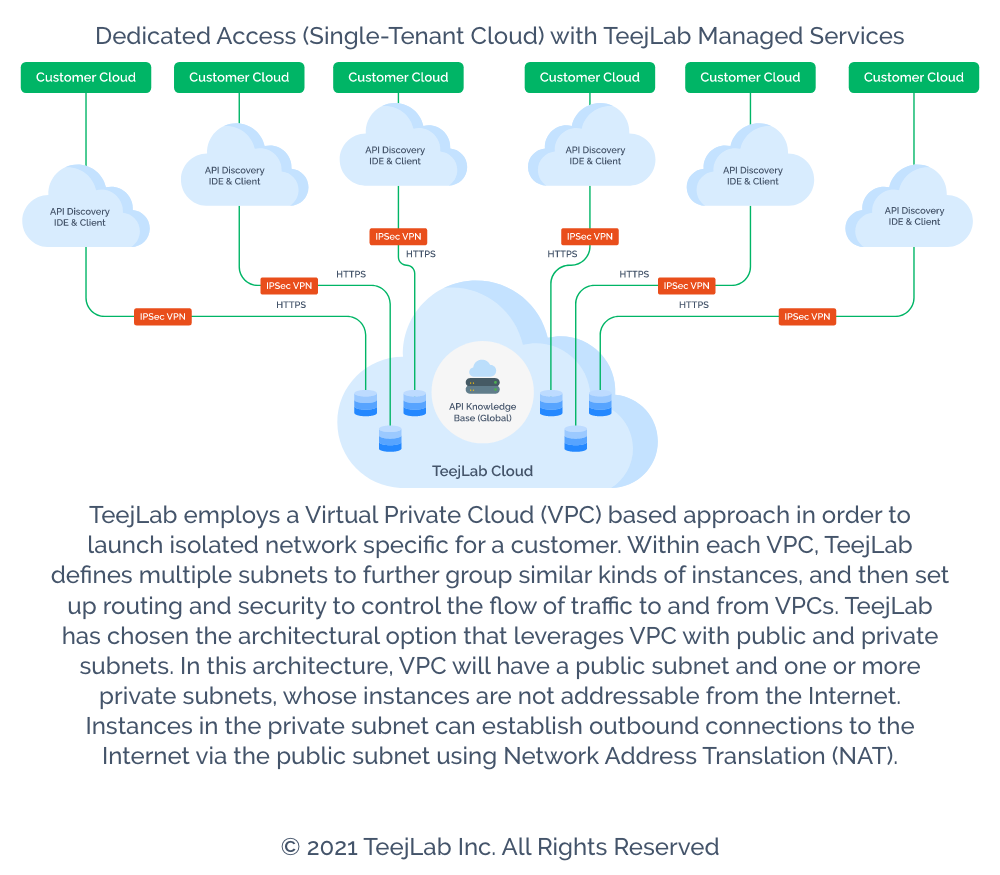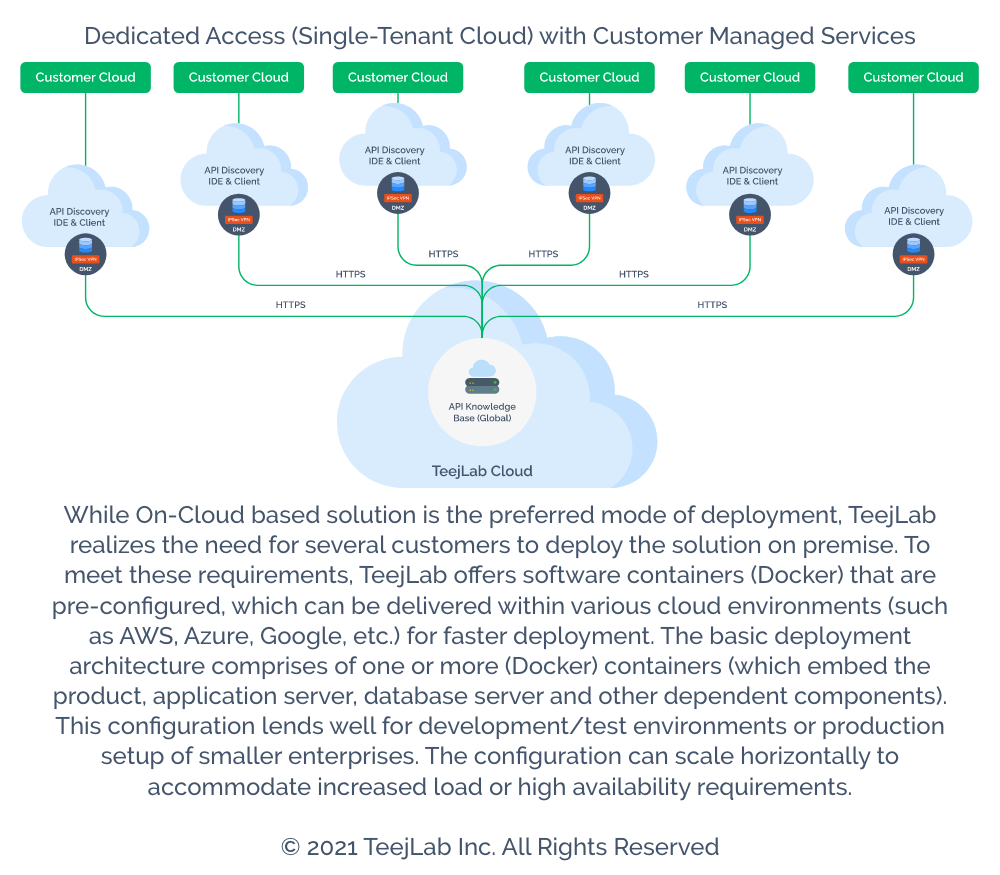Platform Overview
Our platform empowers organizations in building innovative digital solutions through APIs, which are backbone of today's Digital Economy. Our platform does so by tracking APIs at a global scale for their innovation potential as well as their security, legal, and operational constraints. Our platform has world's largest API repository consisting of thousands of APIs from hundreds of industries to provide unprecedented business insights, and enable Digital Transformations in a secure and compliant manner. Our Platform consist of five main products.
Start your Digital Journey with API Discovery then move on with Security, Compliance, Digitization, Monetization and Governance requirements. Each of our products consists of appropriate technical modules to meet your specific Digital Transformation needs. Our cloud-native platform can be deployed as a Software as a Service (SaaS) in a single or multi tenant environment in AWS, Azure, Google, Oracle, or other cloud service providers.
Platform Product Modules
Discovery Manager is designed to help enterprises discover their hidden/shadow APIs by analyzing source code repositories and networks. This product can be deployed within your enterprise systems, using CLI, GUI and IDE support to match your DevSecOps needs.
Security Manager is designed to benchmark your APIs from security, compliance and business risk perspectives by automating OWASP top-10 and CIS top-20 security frameworks to find and mitigate your API-specific vulnerabilities.
Consumer Manager enables you to use myriad of APIs from your partners and 3rd parties in a secure and compliant way.
Producer Manager enables you to expose your APIs to your customers and partners in a seamless, secure and compliant way.
Lifecycle Manager combines all our products to provide you with an end-to-end API management capabilities for API Discovery, Security, Compliance, Digitization, Monetization and Governace requirements. Each of our products consists of various technical modules that are described below.
| Product Modules | API Marketplace | API Software Analysis | API Network Analysis | API Security Workbench | API Quality Workbench | API Service Mesh | API Gateway Mesh | Executive Dashboard |
|---|---|---|---|---|---|---|---|---|
| Discovery Manager |  |
 |
 |
 |
 |
 |
 |
 |
| Security Manager |  |
 |
 |
 |
 |
 |
 |
 |
| Consumer Manager |  |
 |
 |
 |
 |
 |
 |
 |
| Producer Manager |  |
 |
 |
 |
 |
 |
 |
 |
| Lifecycle Manager |  |
 |
 |
 |
 |
 |
 |
 |
| Product Modules | API Marketplace | API Software Analysis | API Network Analysis | API Security Workbench | API Quality Workbench | API Service Mesh | API Gateway Mesh | Executive Dashboard |
|---|---|---|---|---|---|---|---|---|
| Discovery Manager |  |
 |
 |
 |
 |
 |
 |
 |
| Security Manager |  |
 |
 |
 |
 |
 |
 |
 |
| Consumer Manager |  |
 |
 |
 |
 |
 |
 |
 |
| Producer Manager |  |
 |
 |
 |
 |
 |
 |
 |
| Lifecycle Manager |  |
 |
 |
 |
 |
 |
 |
 |
Platform Technichal Modules
Each of our product consists of one more of the eight technical modules: (i) marketplace of public/private APIs, (ii) software composition analysis for discovering APIs, (iii) network analysis for discovering APIs, (iv) API security benchmark, (v) API quality benchmark, (vi) service mesh for APIs, (vii) gateway mesh for APIs, (viii) executive dashboards and reporting.
Solution Deployment Options
Platform can be deployed with a two-fold approach of “physically segregated accounts” (PSA) and “logically segregated accounts” (LSA). In LSA approach, customers can choose to be a tenant on a shared database, which is partitioned “logically” among various customers in a secured/encrypted way. In PSA approach, customers can choose to be a tenant that has its own dedicated database, which remains “physically” isolated from data that belongs to other TeejLab customers. In both approaches, the underlying databases shares a common schema. The application clusters (distributed among various customers) are maintained with appropriate version across different customers. This allows consistency in user experience across all customers with the addition of latest features and functionality being made available at all times. These approaches are explained with more details in Single-Tenant Cloud and Multi-Tenant Cloud sections in figures below.
Why did we come up with API Discovery™?

To help enterprises find APIs that are secure and compliant.

To help enterprises with API Governance and grow their API enconomy.




